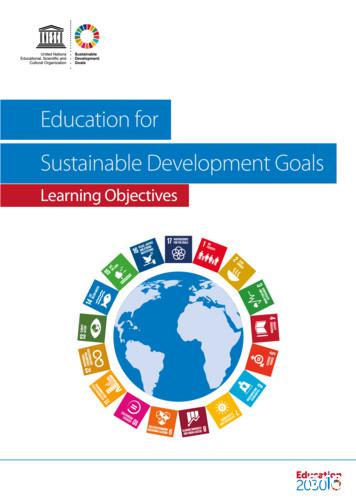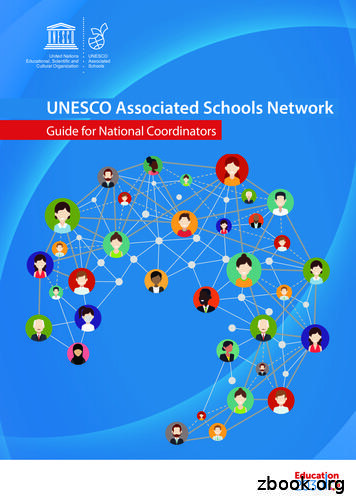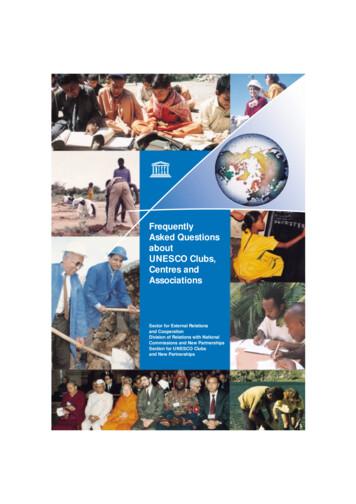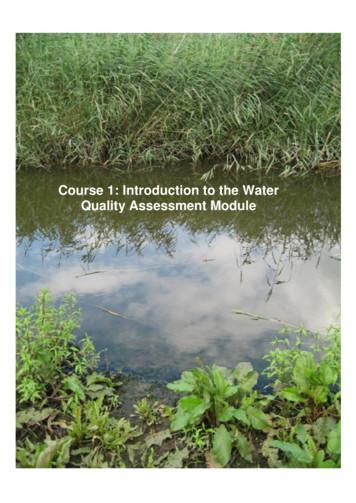W Ater And Education - UNESCO
Water and EducationGeneral Guide for Teachers ofLatin America and the CaribbeanWater and Education for Teachers: General Guide for Teachers of Latin America and the Caribbeani
372.357UNESCO International Hydrological Programme and the Project WETInternational FondationD44Water and Education: General Guide for Teachers of the Americas and the Caribbean.1st edition. United States: UNESCO International Hydrological Programme (IHP), RegionalScience Office for Latin America and the Caribbean, and the Project WET InternationalFoundation, 2007.210 pagesIncludes bibliographyISBN: 978-1-888631-52-41. Water. 2. Environmental education. 3. Teaching material. 2007 UNESCO International Hydrological Programme and the Project WET International Foundation.UNESCO International Hydrological Programme (IHP), Regional Science Office forLatin America and the Caribbean:Edificio MERCOSUR (ex-Parque Hotel)Calle Dr. Luis Piera 1992, 2o PisoPO Box 85911200 Montevideo, UruguayTel: 598 2 413 20 75Fax: 598 2 413 20 94phi@unesco.org.uywww.unesco.org/uy/phiProject WET International Foundation:1001 West Oak St., Suite 210Bozeman, Montana 59715United StatesTel: 001-406-585-2236Fax: ote: Some pages of this guide have copyright specific to the Project WET International Foundation. Thoseactivities are identified with copyright text which reads: 2007, Project WET International Foundation.Nothing in this volume may be copied or reproduced by any means without written permission ot the ProjectWET Foundation and UNESCO-IHP, Latin America and Caribbean Region, except for those pages designatedas student copy pages, which may be reproduced without permission for educational use in conjunction withactivities contained herein.First English edition: 2007iiWater and Education for Teachers: General Guide for Teachers of Latin America and the Caribbean
ForwardDuring the IV World Water Forum, celebrated during March 2006 in Mexico City, a Memorandum of Understanding (MOU) was signed between the International Hydrological Programme (IHP) of UNESCO and the ProjectWET (Water Education for Teachers) Foundation. The goal of this MOU is to increase cooperation between the twoprogrammes and develop water education programmes for Latin America and the Caribbean. As a result of thisagreement, the two organizations have developed the Water and Education joint programme, of which Water andEducation: General Guide for Teachers of Latin America and the Caribbean is a part.This guide includes 32 educational activities, selected and adapted by an international group of specialists from theProject WET Foundation and the UNESCO-IHP, Latin America and Caribbean office. The selection was undertakenwith the help of a team of educators and members of the national committees of UNESCO-IHP and Project WET fromthe Bahamas, Barbedos, Jamaica, Mexico, St. Lucia, Trinidad and Tobago, and the United States.The primary objective of this publication is to facilitate the work of educators and to promote the appreciationof, knowledge about, and respect for water. This joint programme represents a major contribution toward the UNdecades “Water, Fountain of Life,” and “Education for Sustainable Development.” This guide also places specialemphasis on the Education Resolution of the UNESCO Intergovernmental Council, which is included at the end ofthis guide.For more information, contact:Rita Vázquez del MercadoRegional Coordinator,UNESCO/Project WET Joint Programme,Water and EducationMexican Institute of Water TechnologyNational Committee for IHP in Mexicorvazquez@tlaloc.imta.mxProject WET Foundationinfo@projectwet.orgInternational Hydrological ProgrammeRegional Science Office forLatin America and the Caribbeanphi@unesco.org.uyWater and Education for Teachers: General Guide for Teachers of Latin America and the Caribbeaniii
Table of ContentsIntroductory MaterialForward.iiiActivities Listed Alphabetically.viiActivity Format.ixProject WET International Foundation.xInternational Hyrdological Programme (IHP) of UNESCO.xiEditorial Team and Collaborators.xiiAcknowledgements.xiiiBackground and Previous Programmes.xivObjectives.xviReconnecting with Water: Axis IIncredible Journey.22Water in the Air?.27Storm Sleuths.29Seeing Watersheds.34Colour of Water (The).41Tipping the Balance: Global Warming.44Imitating the Landscape.56Pan American Water Games.59Thunderstorm (The).64Blue Planet (The).68Get the Ground Water Picture.70Water, Life, and Health: Axis IISafe Water.81Reaching Your Limits.84Turbidity Test.88Coral Cores.94Aqua Notes.100Aqua Bodies.106World Cup Surge.109No Bellyachers.116Water and Education for Teachers: General Guide for Teachers of Latin America and the Caribbeanv
Humpty Dumpty.120Sum of the Parts.125Super Sleuths.129Water Management: Axis IIICommon Water.140Seeking Solutions.146Color Me a Watershed.149Hot Water.158Whose Problem Is It?.162Long Haul (The).166Water Meter.168What’s Happening?.171AfterMath.175Drop in the Bucket (A).1798-4-1, One For All.183AppendicesUNESCO-IHP Resolution.193Poster 1.194Poster 2.195Poster 3.196Poster 4.197Poster 5.198Cross Reference and Planning Chart.201Glossary.204viWater and Education for Teachers: General Guide for Teachers of Latin America and the Caribbean
Activities Listed Alphabetically8-4-1, One For AllLearn the importance of cooperation when managing water resources. 183AfterMathAssess economic effects of water-related disasters. 139Aqua BodiesEstimate the amount of water in a person, a cactus, or a whale.72Aqua NotesUse music to lean how our bodies use water.110Blue Planet (The)Learn the about statistics and the the percent of Earth covered by water.68Colour Me a WatershedInterpret maps to analyze changes in a watershed.113Colour of Water (The)Students use artwork and observation to learn about water colour.38Common WaterDemonstrate that water is a shared resource.104Coral CoresLearn how environmental conditions impact coral health.110Drop in the Bucket (A)Calculate the availability of fresh water on Earth.143Get the Ground Water PictureCreate an “earth window” to investigate ground water systems.67Hot WaterDebate water issues.122Humpty DumptySimulate a restoration project by putting the pieces of an ecosystem back model together.86Imitating the LandscapeStudents identify and describe physical, biological, and cultural aspects of a landscape. A model is also constructed.53Incredible Journey (The)Simulate the movement of water through Earth’s systems.18Long Haul (The)Haul water to appreciate the amount of water used daily.130Water and Education for Teachers: General Guide for Teachers of Latin America and the Caribbeanvii
No BellyachersShow how pathogens are transmitted by water by playing a game of tag.82Pan American Water GamesCompete in scientific games to investigate adhesion and cohesion.56Reaching Your Limits“Limbo” to learn basic water quality concepts and standards development.78Safe WaterLearn about water-borne disease, water conservation, and water contamination.75Seeing WatershedsLearn how water moves in a watershed and how to find them on maps.34Seeking SolutionsStudents identify and analyze water problems and develop a service learning project.110Storm SleuthsStudents learn about tropical cyclones and create disaster preparedness public awarenss campaigns.26Sum of the PartsDemonstrate point source and non point source pollution.91Super SleuthsSearch for others who share similar symptoms of a waterborne disease.95Thunderstorm (The)Simulate the sounds of a thunderstorm and create precipitation maps.61Tipping the Balance: Global WarmingUse graphing to learn about the relationship between greenhouse gasses and climate change.41Turbidity TestLearn how scientists measure water clarity.110Water MeterConstruct a water meter and keep track of personal water use.132What’s Happening?Conduct a community water use survey.135Whose Problem Is It?Analyze the scope and duration of water issues to determine personal and global significance.126World Cup SurgeDevelop a strategy to accomodate the demands on a wastewater treatment plant.75Water in the Air?Demomstrate the presence of water in the air through a condensation experiment.23viiiWater and Education for Teachers: General Guide for Teachers of Latin America and the Caribbean
Activity FormatThe essential question or a snappy, thoughtprovoking, teaser to introduce the activity.This can be presented as an ice breaker.T SummaryA brief description of the concepts,skills, and affective dimensions ofthe activity.Icon indicates the activity'splacement within the conceptual framework.N Recommende Age:Suggests appropriate agelevel for students. Activitiesare designed for flexibilityand can be adapted for anyage level.N Subject Areas:Disciplines to which theactivity applies.N Duration:ObjectivesThe qualities or skills students shouldpossess after participating in the activity.NOTE: Learning objectives, rather thanbehavioral objectives, were establishedfor Project WET activities. To measurestudent achieve
pr ogrammes and develop water education pr ogrammes for Latin America and the Caribbean. As a r esult of this agr eement, the two or ganizations have developed the W ater and Education joint pr ogramme, of which W ater and Education: General Guide for T eachers of Latin America and the Caribbean is a part.
The UNESCO -IHE Institute for Water Education (UNESCO -IHE) became part of the UNESCO Water Familyduring the 31 st session of the UNESCO General Conference in October 2001 and started its operations in June 2003. Before becoming a UNESCO Category I Institute, UNESCO -IHE
UNESCO Office, Jakarta Publications 2006-2007 UNESCO Office, Jakarta www.UNESCO.or.id Jl. Galuh II no 5. Kebayoran Baru. Jakarta 12110 Tel: 62-21 7399818. Fax: 62-21 72796489 Email: Jakarta@unesco.org UNESCO Librarian : Rosinta P. Hutauruk (rp.hutauruk@unesco.org ) Basic Sciences (BSC) -2007 / 2006 Coastal and Small Island -2007 / 2006
Designed and printed by UNESCO Printed in France UNESCO Education Sector Education is UNESCO’s top priority because it is a basic human right and the foundation on which to build peace and drive sustainable development. UNESCO is the United Nations’ specialized agency for education and the Education Sector provides global and
4 Resolution 1.341, 7th session of the UNESCO General Conference, 1952 5 Document UNESCO/ED/149 of 4 February 1957 6 Document ED/MD/19, 1971 7 UNESCO's Associated Schools Project Network (ASPnet) - List of Participating Institutions, UNESCO 1997 8 Approved Programme and Budget for 1998-1999, Document 29 C/5, Paragraph 06028, UNESCO, 1998 1 1
This brochure was prepared collaboratively by colleagues from the UNESCO Education Sector, including from the Regional bureaux (Bangkok, Beirut, Dakar and Santiago) and the following institutes: UNESCO International Bureau of Education, UNESCO International Institute for Educational Planning, UNESCO
that appeal, the UNESCO Clubs movement gradually spread throughout the world. In 2001, there were more than 5,000 clubs* in more than 120 countries. *The term UNESCO Club is the one most frequently used, although several countries choose to call them UNESCO associations, centres, circles, or friends of UNESCO. They all refer to the same type of .
1.2. UNESCO-IHE Institute for Water Education (source: www.unesco-ihe.org) The UNESCO-IHE Institute for Water Education is established in 2003. It carries out research, education and capacity building activities in the fields of water, environment and infrastructure. UNESCO-IHE continues the work that began in 1957 when IHE first
Magnetic Flux Controllers in Induction Heating and Melting Robert Goldstein, Fluxtrol, Inc. MAGNETIC FLUX CONTROLLERS are materials other than the copper coilthat are used























